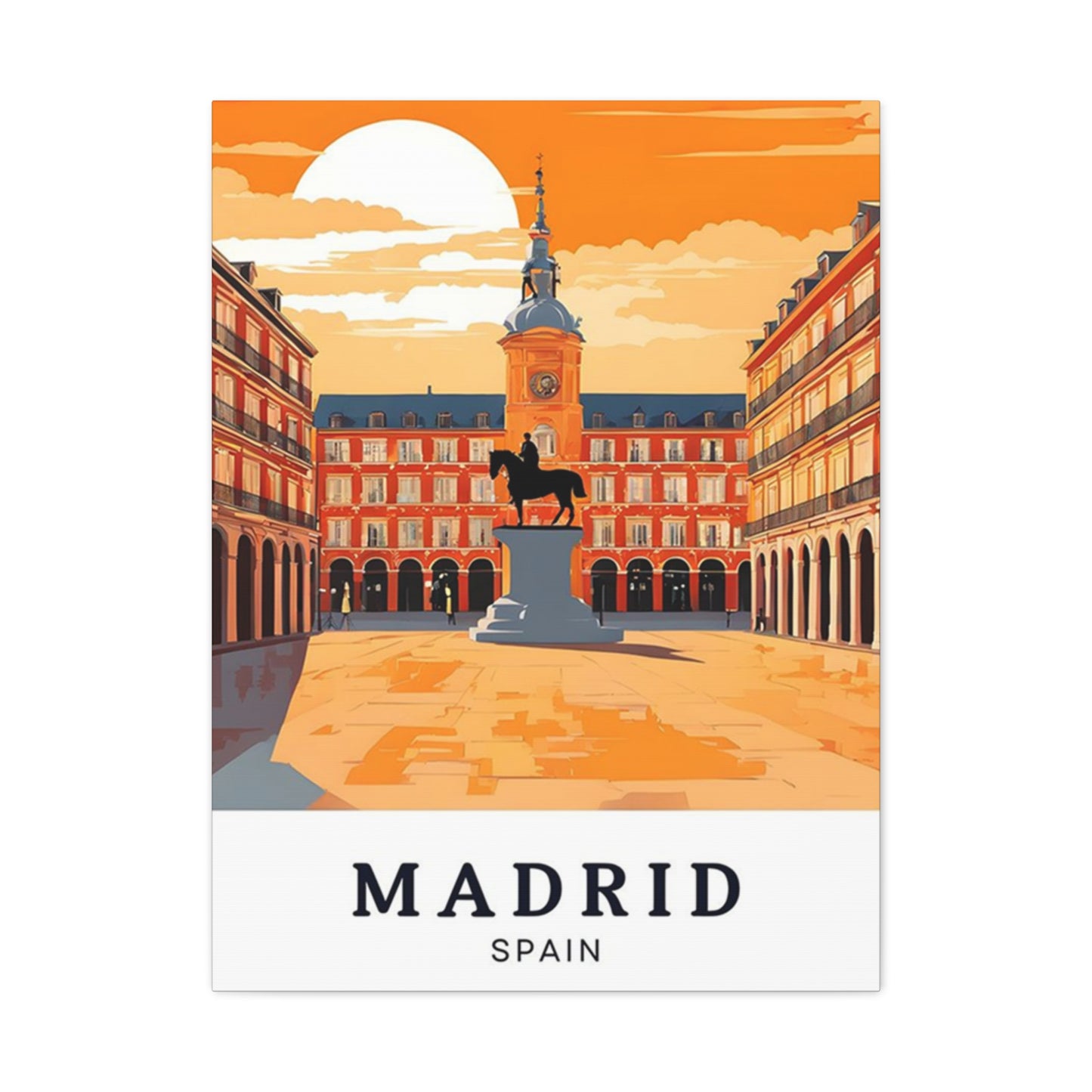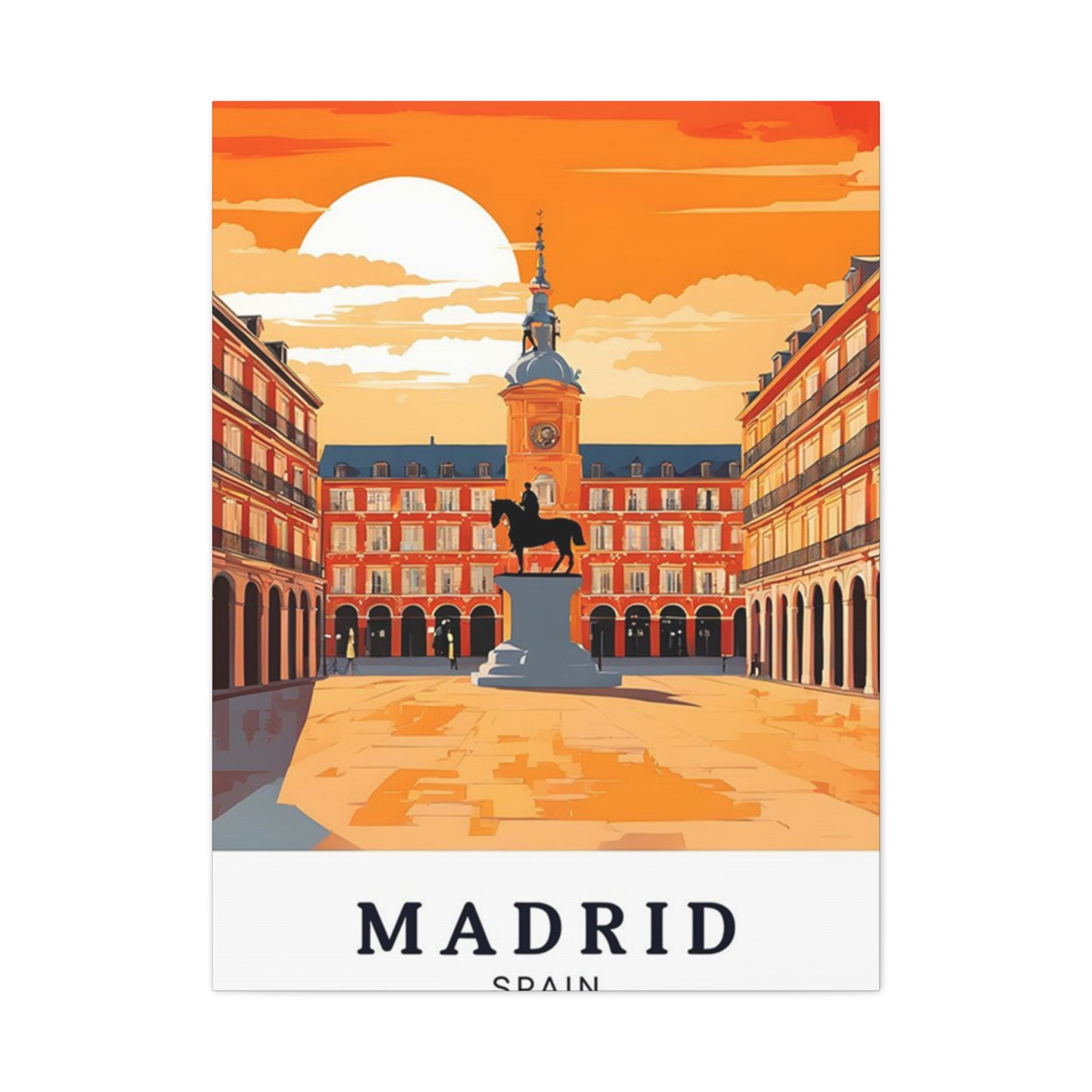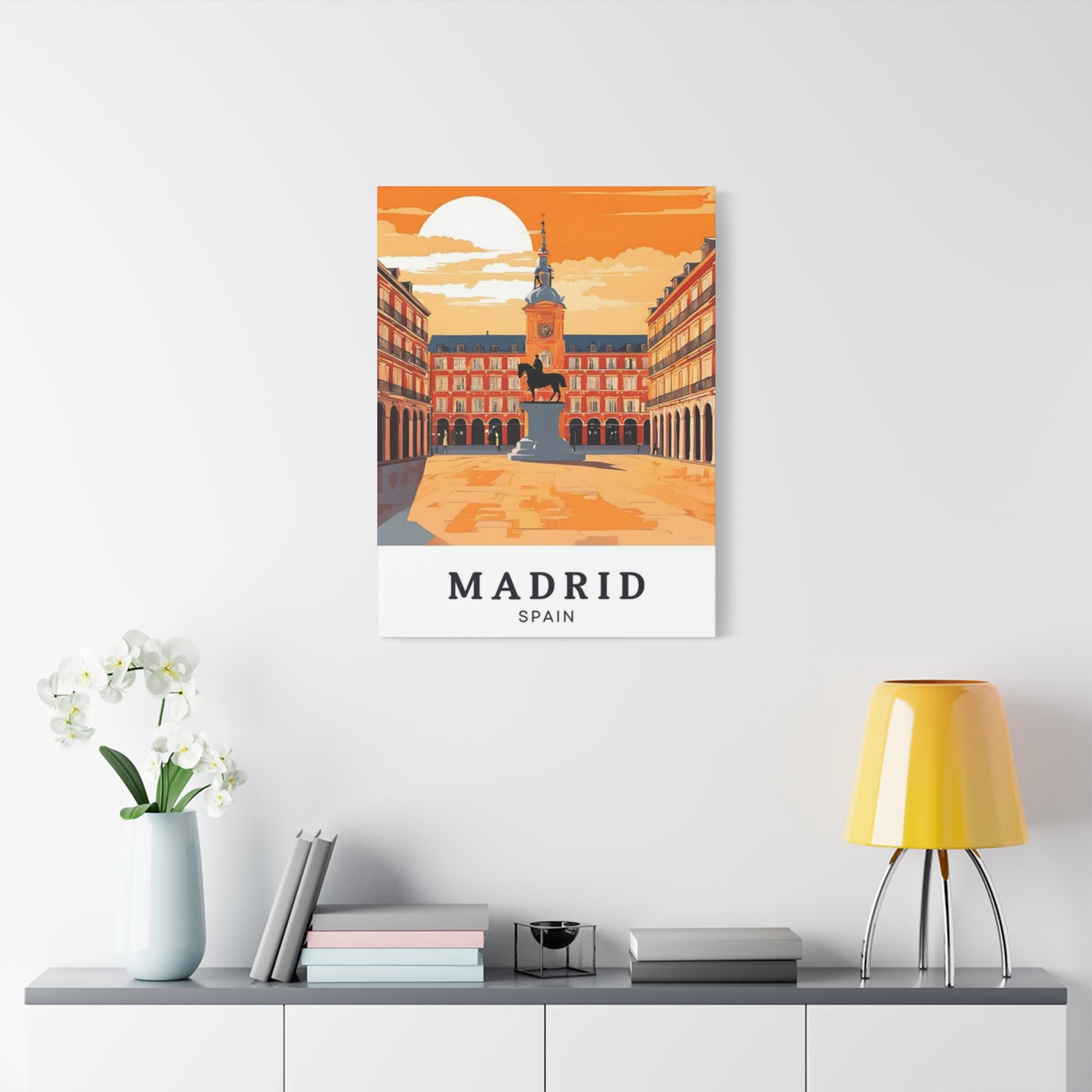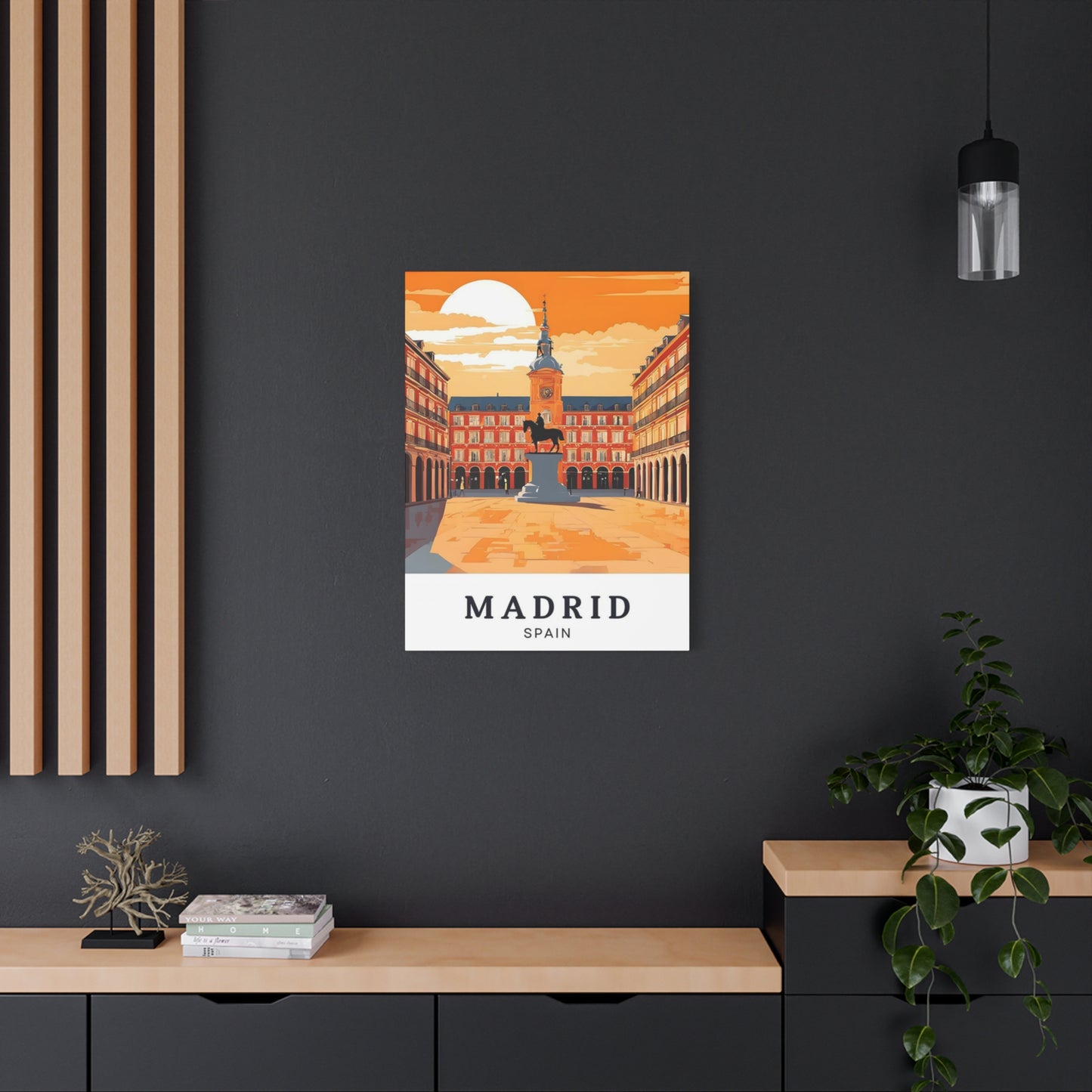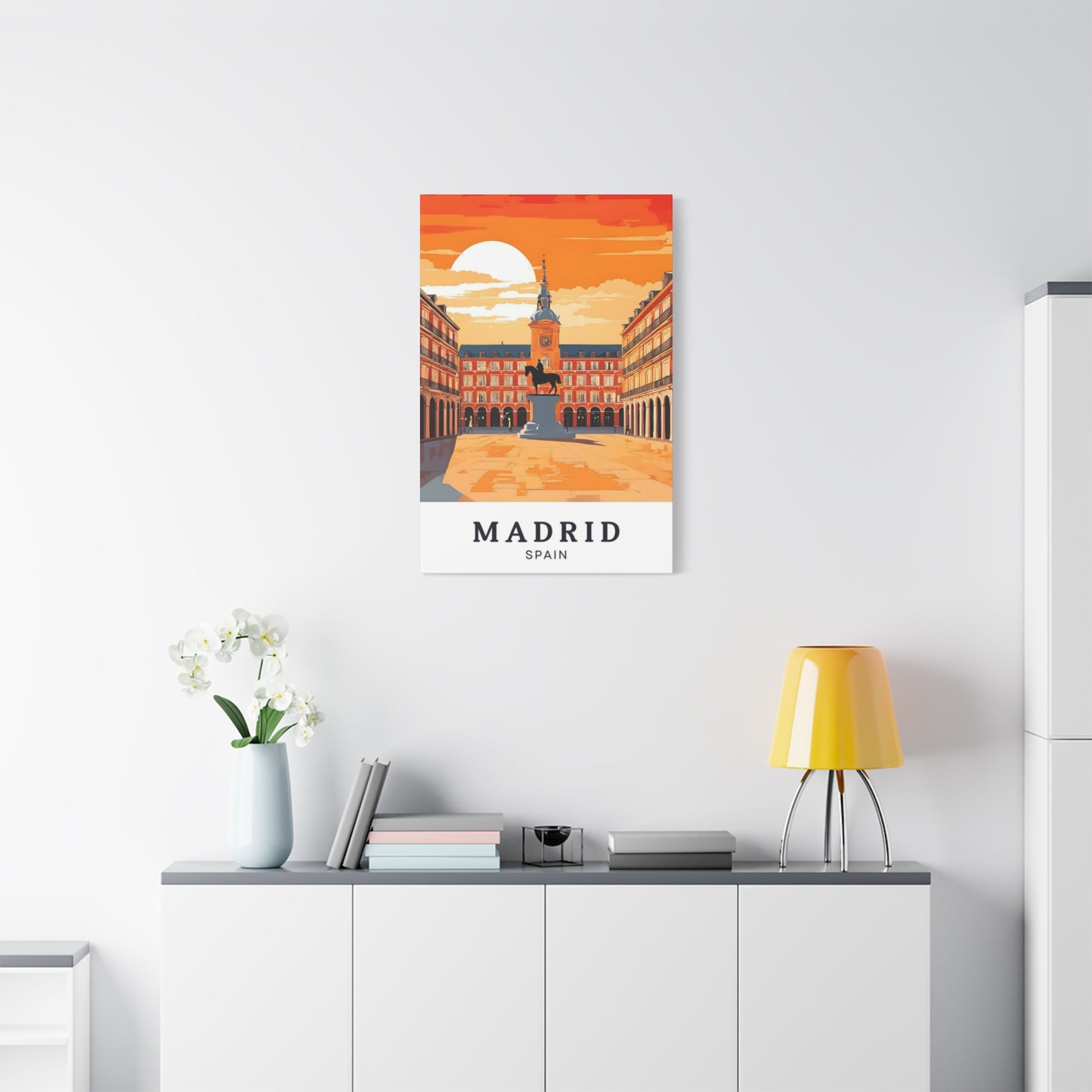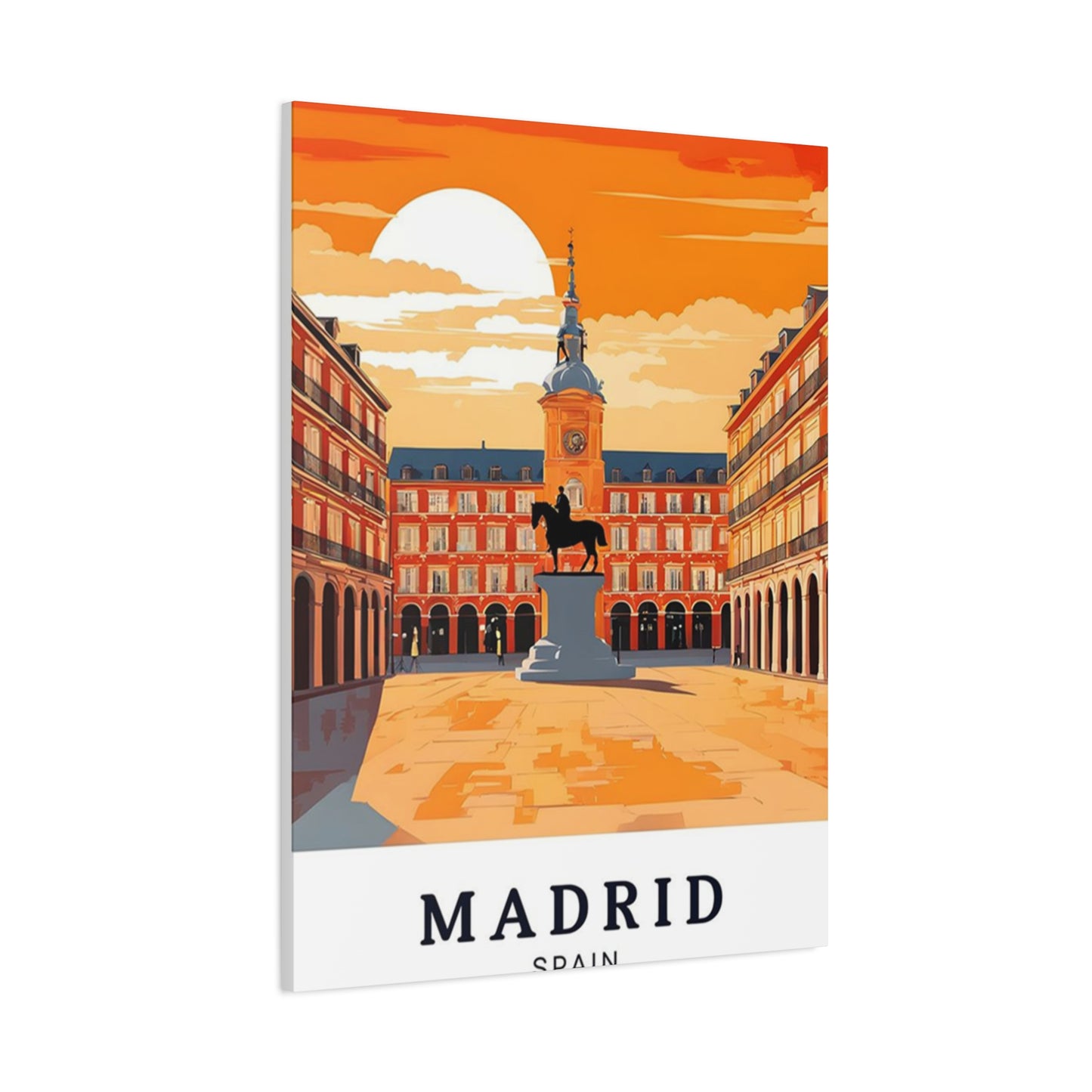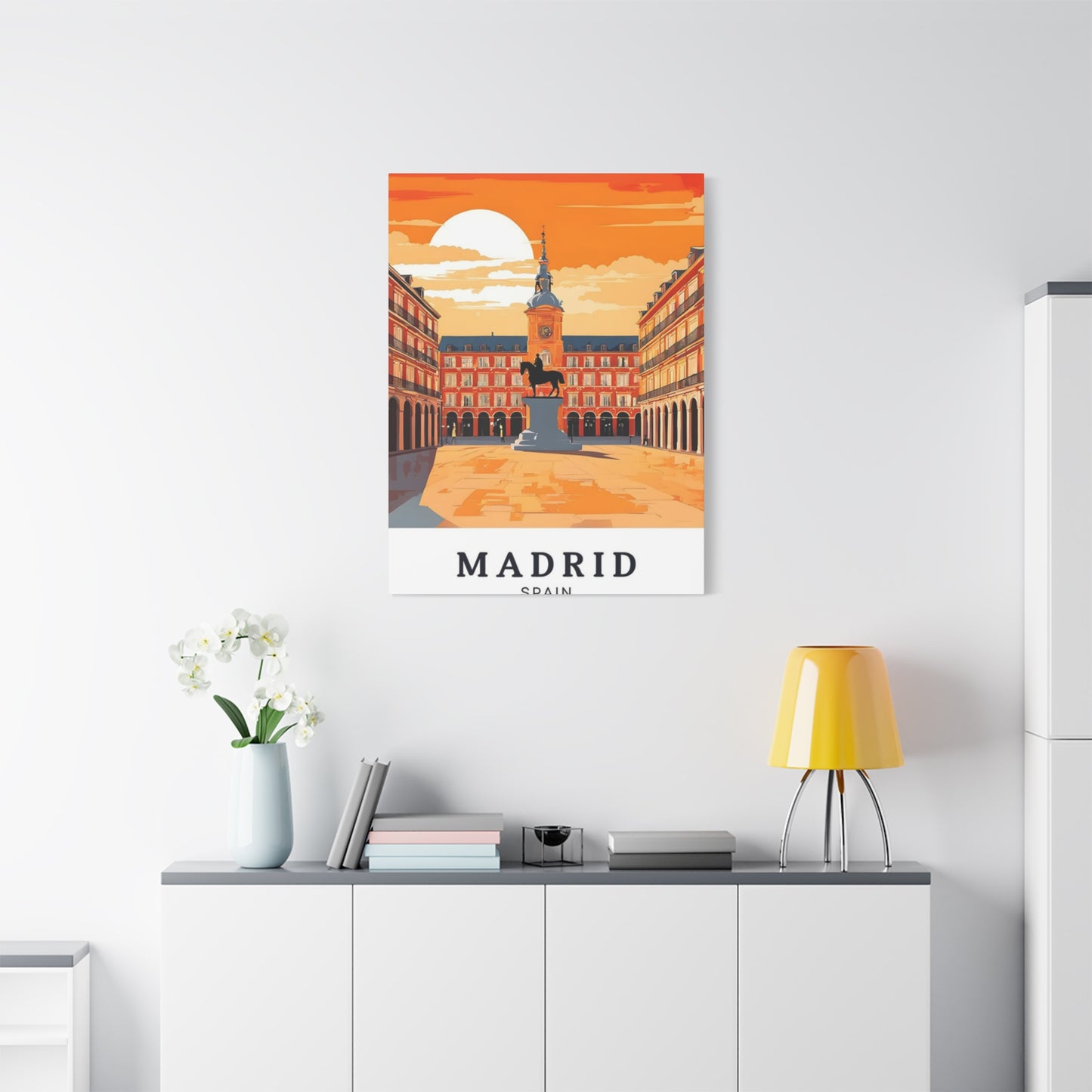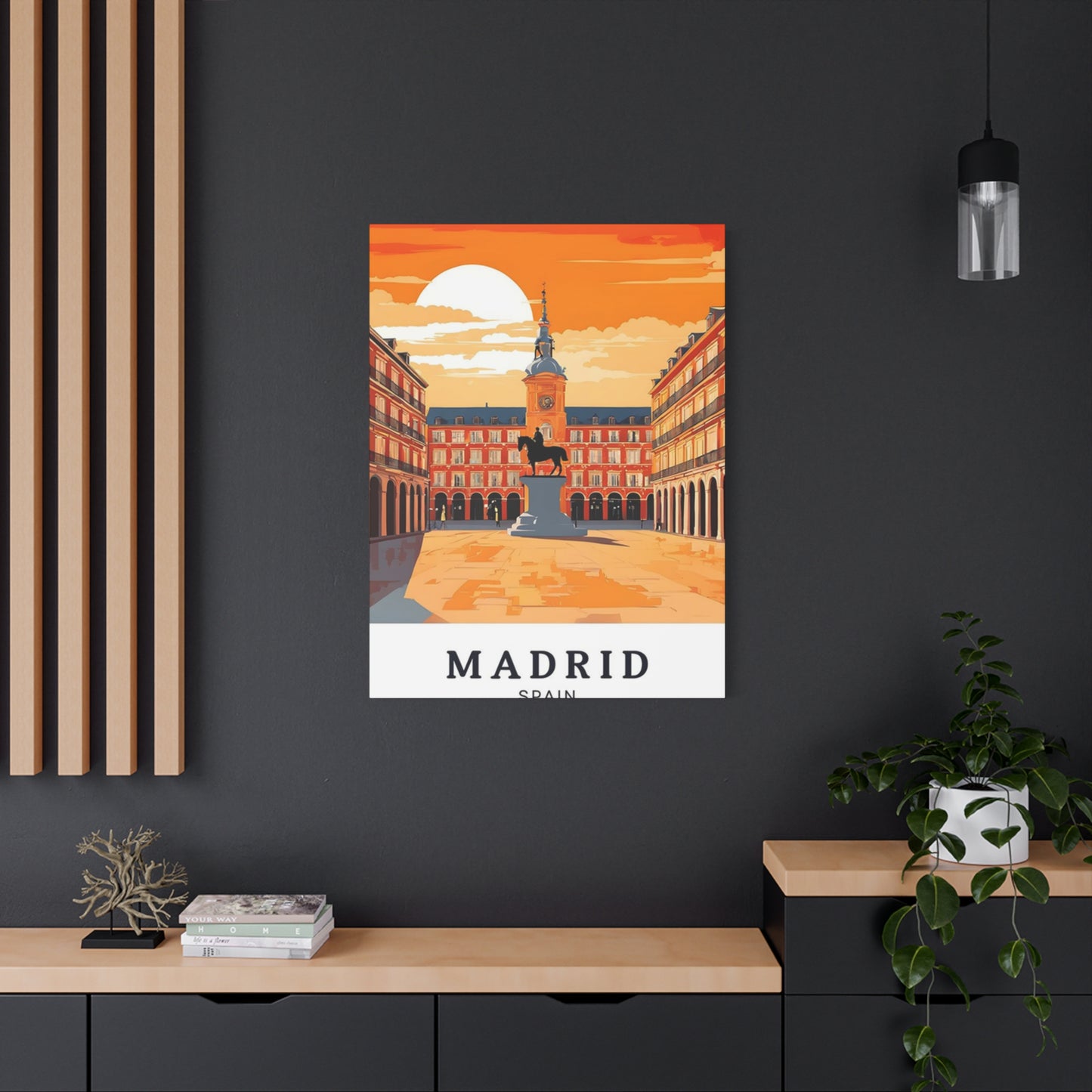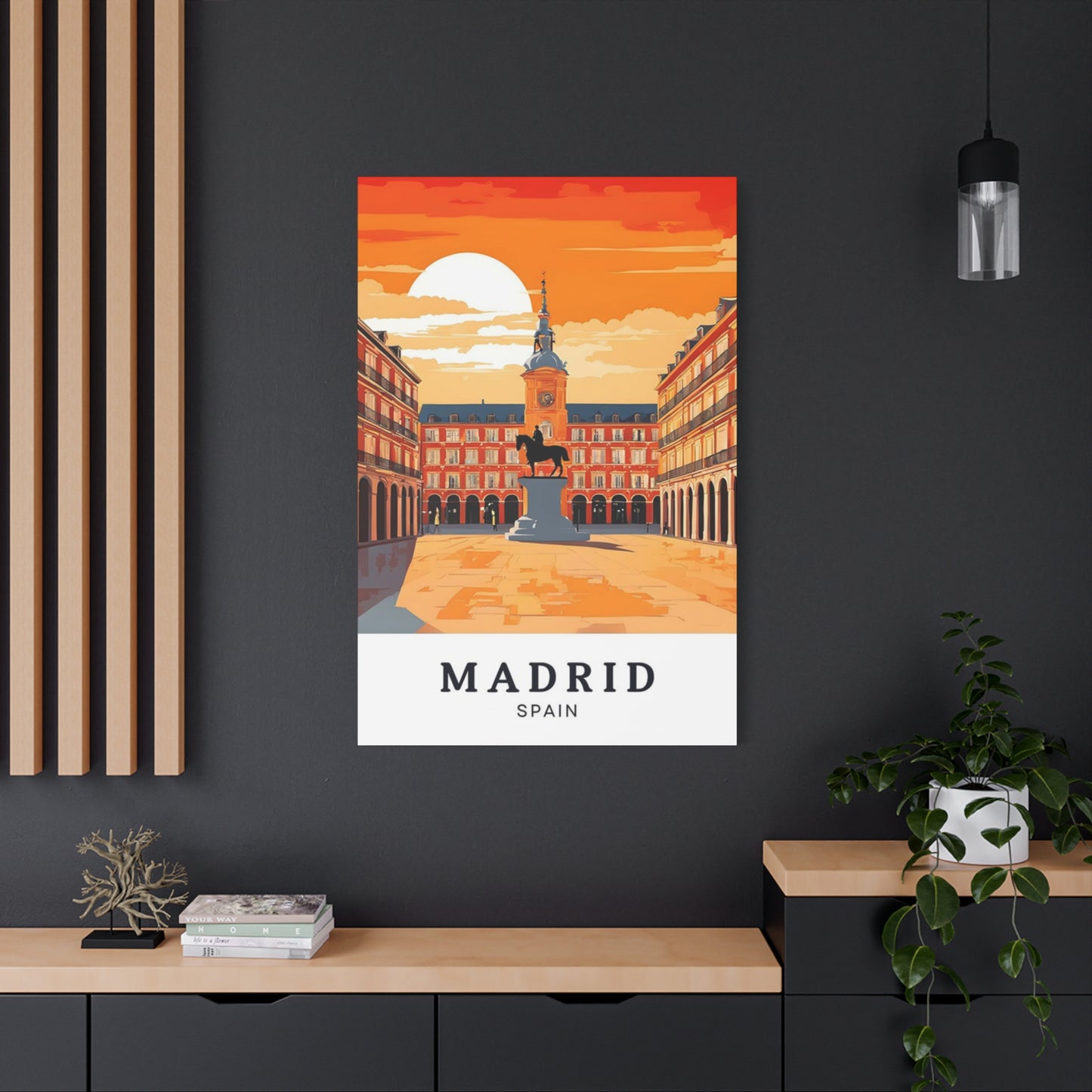Elevate Your Space: Madrid Spain poster Wall art for Every Room and Style
Madrid, the vibrant capital of Spain, has long captivated hearts with its rich cultural heritage, stunning architecture, and passionate energy. Bringing the essence of this magnificent city into your living spaces through carefully curated poster art can transform ordinary walls into extraordinary visual experiences. The magic of Madrid-inspired wall decorations lies in their ability to transport you to the sun-drenched plazas, historic boulevards, and artistic neighborhoods of this remarkable European destination, all while enhancing your interior design with sophisticated elegance.
When considering decorative elements for your home or office, Madrid-themed artwork offers an exceptional blend of worldly sophistication and accessible style. These pieces serve as windows to another world, inviting contemplation and conversation while adding depth and character to any environment. Whether you're drawn to architectural photography showcasing the grandeur of Royal Palace facades, abstract interpretations of the city's colorful street life, or vintage travel posters reminiscent of mid-century wanderlust, Madrid poster art provides endless possibilities for personal expression and aesthetic enhancement.
The beauty of incorporating Spanish capital imagery into your decorating scheme extends beyond mere visual appeal. These pieces carry stories, memories, and aspirations. For travelers who have wandered through Retiro Park or savored tapas in La Latina, these artworks become treasured reminders of experiences lived. For dreamers planning future adventures, they serve as daily inspiration and motivation. And for design enthusiasts seeking to create spaces with international flair, they offer an authentic touch of European sophistication that elevates any room from ordinary to exceptional.
Illuminate Your Living Areas with Spanish Capital Artwork
Transforming your walls with artwork featuring the Spanish capital creates an immediate impact that radiates throughout your entire living space. The warm tones characteristic of Madrid's terracotta rooftops, golden hour lighting, and ochre-colored buildings bring an inviting warmth that makes any room feel more welcoming and lived-in. These pieces work particularly well in spaces where you want to encourage relaxation and conversation, as the imagery naturally draws the eye and provides fascinating focal points that guests will want to discuss.
Consider how different lighting conditions throughout the day interact with your chosen artwork. Madrid's famous luminosity, often captured in photography and artistic renderings of the city, can actually enhance the natural light in your room. Placing these pieces on walls that receive indirect sunlight allows the colors to shift subtly throughout the day, creating a dynamic visual experience that keeps your space feeling fresh and alive. The interplay between natural light and the depicted scenes can make you feel as though you're watching the city change from morning to evening, bringing a sense of movement and life to static walls.
The psychological impact of surrounding yourself with imagery of beautiful, culturally rich destinations cannot be overstated. Studies in environmental psychology suggest that artwork depicting places associated with positive experiences or aspirations can significantly improve mood and reduce stress levels. When you incorporate Madrid-themed pieces into your daily environment, you're not just decorating walls but creating an atmosphere that supports your emotional well-being. Each glance at a stunning vista of Gran Via or a charming illustration of Plaza Mayor can provide a momentary mental escape, a brief vacation for your mind amidst the demands of daily life.
Choosing pieces that resonate with your personal connection to the city enhances this effect exponentially. Perhaps you honeymooned in Spain's capital, studied there during university, or have always dreamed of visiting. Selecting artwork that reflects these personal narratives adds layers of meaning to your decorating choices, transforming your space into a visual autobiography. The walls become storytelling canvases, speaking to who you are, where you've been, and where you hope to go. This personalization elevates interior design from mere aesthetics to genuine self-expression.
Wanderlust-Inspired Spanish Capital Decorations
Travel-themed decorating has surged in popularity as people seek to infuse their homes with the excitement and wonder of exploration. Madrid wall decorations fit perfectly into this aesthetic movement, offering sophisticated European charm that appeals to the adventurous spirit. Unlike generic travel imagery, pieces featuring Spain's capital carry specific cultural weight and architectural distinctiveness that make them stand out in the crowded field of destination-inspired decor.
The appeal of travel-focused interior design lies in its ability to keep the spirit of adventure alive in everyday spaces. When you can't physically be in Madrid sipping cafe con leche at a sidewalk cafe, having visual reminders of such experiences keeps those memories vibrant and accessible. These pieces serve as bridges between the ordinary and the extraordinary, reminding you that adventure and beauty exist and are worth pursuing. They keep the traveler's mindset active even during periods when actual travel isn't possible, maintaining that sense of curiosity and openness to new experiences.
Curating a collection that represents various aspects of Madrid creates a more comprehensive and interesting display. Rather than focusing solely on famous landmarks, consider mixing architectural photography with street scenes, cultural imagery with natural landscapes, and historic representations with contemporary interpretations. This variety not only creates more visual interest but also presents a more nuanced, authentic portrait of the city. Madrid is not just its monuments but also its people, neighborhoods, traditions, and daily rhythms. Capturing this complexity in your wall displays creates depth and prevents the one-dimensional feeling that can result from overly touristy imagery.
The geography of Madrid itself offers diverse visual opportunities for wall art. From the formal grandeur of the Royal Palace to the bohemian creativity of Malasana, from the expansive greenery of Casa de Campo to the modernist skyscrapers of Cuatro Torres, the city presents countless faces. Selecting pieces that highlight this diversity demonstrates both sophisticated taste and genuine appreciation for the destination beyond its postcard-perfect highlights. It shows you understand the city as a living, complex place rather than just a collection of photo opportunities.
Seasonal variations in Madrid imagery can also keep your decorating fresh and relevant throughout the year. Spring blossoms in the Botanical Garden, summer festivals and outdoor dining scenes, autumn colors in Retiro Park, and the magical Christmas lights along Gran Via each offer distinct aesthetic qualities. Rotating your displayed pieces seasonally creates an evolving decor scheme that prevents visual boredom and keeps your space feeling current and thoughtfully maintained. This practice also allows you to own more pieces than you display simultaneously, giving you flexibility and options.
Elegant Spanish Capital Canvas Options
Canvas prints featuring Madrid scenes bring gallery-quality sophistication to residential and commercial spaces alike. The texture and depth that canvas provides elevates photographic and artistic images beyond what standard paper prints can achieve. The slight three-dimensionality created by stretched canvas gives artwork a presence and substance that commands attention and respect, making even modestly sized pieces feel significant and valuable.
The durability of canvas makes it particularly suitable for high-traffic areas and spaces where longevity matters. Unlike paper-based prints that can tear, crease, or show wear relatively quickly, properly produced canvas prints maintain their appearance for years with minimal care. This resilience makes them excellent investments for those who want decorating solutions that will continue looking fresh and intentional rather than dated or damaged. The slight texture of canvas also helps hide minor imperfections and fingerprints better than glossy or smooth surfaces, maintaining a cleaner appearance with less maintenance.
When selecting canvas prints, pay attention to the quality of both the image reproduction and the canvas material itself. Higher thread counts in canvas create smoother surfaces that render fine details more accurately, particularly important for architectural photography or pieces with intricate elements. The printing technology used also matters significantly, with giclée printing representing the highest quality for color accuracy, fade resistance, and overall image clarity. Investing in well-produced pieces ensures your Madrid artwork continues looking vibrant and sharp rather than fading or degrading over time.
Entrance Area Enhancement with Spanish Capital Art
First impressions matter profoundly, and your entryway sets the tone for your entire home. Incorporating Madrid-themed decorations in this transitional space immediately communicates cosmopolitan taste and cultural appreciation to visitors. The entryway presents unique decorating challenges due to its typically compact size and transitional nature, but these constraints actually make it ideal for impactful artwork that doesn't require extensive wall space to make a statement.
Vertical compositions work particularly well in entryways, which often feature narrow wall sections between doors, windows, and closets. Madrid's architecture, with its tall buildings, church spires, and street scenes shot from low angles emphasizing height, naturally lends itself to vertical formats. These elongated pieces draw the eye upward, creating the illusion of greater ceiling height and more spacious feelings in typically cramped entry areas. A striking vertical canvas of Madrid's skyline or a narrow street in the old city can transform a formerly overlooked wall into a memorable greeting.
Lighting in entryways often lacks the natural abundance found in main living areas, making artwork selection even more critical. Choosing Madrid pieces with inherent brightness, warm colors, or high contrast ensures they remain visible and impactful even in lower light conditions. Images featuring Madrid's famous golden hour lighting, sunlit plazas, or illuminated night scenes bring their own luminosity to darker spaces. Consider adding picture lighting or strategically positioned accent lights to ensure your artwork receives proper illumination, enhancing both the piece itself and the overall ambiance of the entrance.
The entryway also serves a practical function as a transitional zone where people arrive and depart, making it psychologically significant beyond mere aesthetics. Artwork in this space can set emotional tones and mental frameworks for both leaving and returning home. A beautiful Madrid scene can inspire thoughts of adventure and possibility as you head out, while welcoming you back with reminders of beauty and culture when you return. This psychological dimension adds functional value to decorative choices, making the entryway work harder than simply looking attractive.
Coordination with functional entryway elements creates cohesive, intentional design. Consider how your Madrid artwork relates to hooks, benches, console tables, mirrors, and other necessities of entry spaces. Using the artwork as a starting point for color schemes that extend to these practical elements unifies the space. A Madrid poster featuring warm terracotta tones might inspire a rust-colored bench cushion or copper-toned hooks. This thoughtful coordination demonstrates design sophistication and creates spaces that feel curated rather than haphazardly assembled.
Understated Spanish Capital Decorating Concepts
Minimalist design philosophy emphasizes quality over quantity, intentionality over excess, and negative space as an active design element. Madrid artwork fits beautifully into minimalist schemes when selected and displayed thoughtfully. The key lies in choosing pieces that embody simplicity while still carrying visual interest and emotional resonance. Clean architectural photography, line drawings of famous landmarks, or abstract interpretations of the city's essence all work within minimalist parameters while bringing cultural sophistication.
Color restraint characterizes successful minimalist applications of Madrid imagery. While the city itself bursts with color, minimalist approaches benefit from limiting palettes to just a few complementary tones. Black and white photography of Madrid's architecture, for instance, brings all the cultural cachet and visual interest without the potential chaos of multiple competing colors. Sepia-toned vintage representations or monochromatic illustrations similarly provide sophistication with restraint. These approaches allow the forms, compositions, and subjects to speak for themselves without color overwhelming the senses.
Scale and placement become even more critical in minimalist contexts where each element receives heightened attention due to lack of visual competition. A single, perfectly chosen Madrid piece can anchor an entire minimalist room, with its placement determining the spatial hierarchy and flow of the space. Centering a piece on an otherwise empty wall creates formal balance and deliberate focus. Offsetting it according to golden ratio principles introduces subtle dynamic tension. The generous negative space surrounding the artwork in minimalist settings actually enhances its impact, giving it room to breathe and allowing viewers to fully appreciate its qualities without distraction.
Frame selection for minimalist Madrid art demands particular attention to simplicity and quality. Thin black metal frames, natural light wood with minimal profiles, or frameless floating mounts all support minimalist aesthetics without adding unnecessary visual weight. The frame should essentially disappear, serving its protective and presentational functions without calling attention to itself. This restraint ensures the artwork remains the focus while the framing elements provide just enough structure to feel complete and intentional.
Spanish Heritage Through Capital City Artwork
Spain's rich cultural legacy finds concentrated expression in its capital city, where centuries of art, architecture, literature, and tradition converge. Decorating with Madrid-inspired pieces connects your space to this deep cultural heritage, adding layers of meaning that transcend simple aesthetics. The charm inherent in Spanish design sensibilities, characterized by warmth, passion, and appreciation for both grandeur and intimate moments, translates beautifully into residential decorating.
Traditional Spanish design elements found throughout Madrid offer inspiration for coordinated decorating schemes. The ironwork balconies, ceramic tile details, carved wooden doors, and ornate plasterwork that characterize Madrid architecture can inform choices beyond wall art. When your Madrid pieces feature these elements, you can echo them in other decor selections, creating thematic consistency. Wrought iron candle holders, ceramic vases, or wooden furniture pieces that share aesthetic DNA with your artwork create harmonious spaces that feel authentically inspired rather than superficially themed.
The artistic legacy of Spain, from Velázquez and Goya to Picasso and Dalí, has shaped Madrid's identity as a cultural capital. While reproductions of famous paintings require different considerations, Madrid artwork that reflects this artistic heritage through style, subject matter, or approach carries some of that creative energy. Pieces that show Madrid through artistic rather than purely photographic lenses connect to this tradition, bringing creative interpretation and personal vision into your space. This artistic dimension elevates decoration into something more meaningful, surrounding yourself with creative expression rather than mere representation.
Spanish attitudes toward color, pattern, and ornamentation differ from northern European or American minimalism, embracing richness and complexity with confidence. Madrid artwork often reflects this sensibility, featuring bold colors, intricate details, and layered compositions that reward extended viewing. Incorporating these pieces into your decor can liberate you from overly restrained design approaches, giving you permission to embrace more maximalist tendencies if that's where your inclinations lie. The Spanish example demonstrates that richness and sophistication aren't mutually exclusive, that more can indeed be more when executed with skill and intention.
Food culture, so central to Madrid life, also offers decorating inspiration. Images of bustling markets, tapas bars, or traditional restaurants capture not just visual appeal but entire sensory experiences and social traditions. These pieces remind viewers that Madrid's charm isn't solely architectural or artistic but fundamentally human and experiential. Displaying such imagery can inspire you to embrace similar values in your own life: prioritizing shared meals, savoring quality ingredients, and treating dining as social ritual rather than mere refueling. Your wall art becomes not just decoration but gentle encouragement toward valued lifestyles.
Creative Home Styling Using Spanish Capital Pieces
Taking a hands-on approach to incorporating Madrid-themed artwork into your home allows for maximum personalization and creative expression. Do-it-yourself styling doesn't necessarily mean creating the artwork itself but rather thoughtfully curating, arranging, and integrating pieces into your unique space in ways that reflect your individual taste and lifestyle. This approach transforms decorating from passive consumption into active creative practice.
Creating gallery walls remains one of the most popular and effective methods for displaying multiple Madrid pieces together. The key to successful gallery walls lies in establishing some organizing principle, whether symmetry, color progression, size graduation, or thematic connection, that unifies diverse elements into a cohesive whole. For Madrid collections, you might group pieces by neighborhood, organizing architectural shots of La Latina together, Retiro Park scenes in another cluster, and Gran Via imagery in a third section. This geographical organization creates mini-exhibitions within your larger display, adding educational and narrative dimensions to pure aesthetics.
Mixing Madrid artwork with other decorative elements creates more dynamic, personalized displays. Combining framed pieces with three-dimensional objects like small sculptures, plants, or travel souvenirs from Spain adds depth and texture that purely two-dimensional displays lack. A shelf arrangement might feature a Madrid canvas flanked by small ceramic tiles from Valencia, a vintage Spanish guidebook, and a succulent in a terracotta pot. These combinations tell richer stories than artwork alone, creating vignettes that reveal personality and experience.
Seasonal styling updates keep your Madrid displays feeling fresh and relevant throughout the year. During summer, emphasize pieces featuring outdoor scenes, festivals, and vibrant colors. As autumn arrives, transition to cozier images of cafes, rainy streets, or fall foliage in city parks. Winter invites focus on holiday decorations, museum interiors, and architectural details. Spring celebrates renewal with garden scenes and blossom-filled plazas. This rotating approach means you can own more pieces than you display simultaneously, keeping a reserve that allows regular refreshing without additional purchases.
Striking Visual Impact with Spanish Capital Canvas
Making bold decorating statements requires confidence and commitment to strong visual elements that command attention and define spaces. Oversized Madrid canvas pieces excel at this role, creating immediate impact that establishes aesthetic tone and spatial hierarchy. When you enter a room featuring a dramatic, large-scale Madrid canvas, there's no question about the design intention or the space's character. This clarity and confidence in decorating choices creates sophisticated, memorable interiors.
Scale relationships between artwork and furniture determine whether pieces feel appropriately sized or awkwardly proportioned. A general rule suggests artwork should occupy roughly two-thirds to three-quarters the width of furniture pieces it hangs above, though this guideline flexes based on context. For statement pieces, erring slightly larger often creates more impact than going too small. A substantial Madrid canvas above a sofa becomes a focal point that anchors the seating area and draws the eye immediately upon entering the room. This anchoring effect helps organize space psychologically, giving viewers a clear starting point for understanding the room's layout and purpose.
Color intensity in statement pieces affects their impact and longevity in your space. While bold, saturated colors create immediate drama, they can also overwhelm or tire viewers over time. Many designers recommend slightly muted or complex color palettes for pieces intended to remain displayed long-term, reserving the most intense hues for accent pieces you can rotate. Madrid imagery offers both options: vibrant street scenes and sunset vistas provide high-intensity color, while architectural studies and atmospheric photography offer sophistication through subtlety. Consider your tolerance for visual stimulation and how long you intend to keep the piece displayed when selecting color intensity.
Subject matter selection for statement pieces benefits from choosing imagery with depth and complexity that rewards repeated viewing. Simple, obvious compositions lose their interest relatively quickly, while layered, nuanced images continue revealing new details and interpretations over time. A Madrid scene featuring multiple planes of depth, interesting light and shadow play, or complex compositional elements maintains interest much longer than straightforward landmark photography. Think of your statement piece as something you'll see daily for years, selecting accordingly for staying power rather than immediate novelty.
Sleeping Space Transformation Using Spanish Capital Art
Bedrooms serve as personal sanctuaries where aesthetic choices affect mood, relaxation, and even sleep quality. Selecting Madrid artwork for these intimate spaces requires considering not just visual appeal but emotional resonance and psychological impact. The pieces you choose to surround your most vulnerable, restful moments should inspire feelings of peace, romance, inspiration, or whatever emotions you wish to cultivate in your personal retreat.
Placement options in bedrooms typically center on the wall above the bed, which serves as the natural focal point in most bedroom layouts. This prominent position demands artwork that balances visual interest with relaxation-promoting qualities. Extremely busy or jarring images might create restless energy counterproductive to sleep, while overly bland pieces fail to provide the inspiration that makes waking up pleasant. Madrid scenes offering beautiful but calm compositions, perhaps featuring serene parks, elegant architecture, or soft-focus romantic imagery, strike the right balance for most bedroom applications.
Color psychology plays a particularly important role in bedroom decorating, as colors genuinely affect nervous system responses and emotional states. Warm, muted tones generally promote relaxation better than bright, cool colors, though personal preferences vary. Madrid imagery rich in terracottas, soft golds, dusky pinks, and warm grays creates soothing environments conducive to rest. If your bedroom serves dual purposes as both sleeping space and home office or reading room, positioning more energizing Madrid pieces in work zones while keeping calming images in the sleeping area creates appropriate zoning within a single room.
Symmetry in bedroom design often feels more restful than asymmetry, an exception to the dynamic tension that enhances other spaces. Flanking your bed with matching nightstands and lamps creates balanced, settled feelings, and your Madrid artwork can reinforce this through centered placement and internal symmetry. Images featuring balanced compositions, central perspectives, or mirrored elements support this restful symmetry. Alternatively, if your personal style runs more eclectic, asymmetrical arrangements can express personality while still maintaining bedroom-appropriate energy through careful piece selection.
Personal significance of bedroom artwork matters more here than perhaps anywhere else in your home. Since bedrooms are private spaces not typically displayed to guests, you have complete freedom to choose pieces based purely on personal meaning without concern for others' reactions. A Madrid image from your engagement trip, study abroad experience, or dream destination list carries emotional weight that enhances your personal connection to the space. This emotional resonance makes the bedroom truly yours, reflecting your memories, aspirations, and innermost self in ways public spaces cannot.
Multi-Dimensional Spanish Capital Wall Arrangements
Layered decorating approaches create sophisticated, collected-over-time aesthetics that feel personal and curated rather than purchased wholesale. Incorporating Madrid artwork into layered arrangements requires balancing multiple elements while maintaining visual coherence, a skill that develops through experimentation and attention to successful examples. The resulting displays carry complexity and depth that single-piece presentations cannot achieve.
Combining various art formats creates textural interest that flat, uniform presentations lack. Mixing framed Madrid prints with canvas pieces, metal prints, or even three-dimensional elements like carved wood or ceramic tiles creates visual variety that engages viewers more fully. Each medium has distinct characteristics, with canvas offering warmth and texture, metal providing sleek modernity, traditional frames adding formality, and dimensional objects contributing physical depth. This variety within a Madrid theme prevents monotony while maintaining thematic cohesion.
Overlapping elements partially obscuring others creates casual, collected feelings rather than rigid precision. Leaning smaller framed Madrid prints against the wall atop furniture or shelving, with pieces partially overlapping, suggests ongoing curation and personal involvement with your displays. This approach feels more approachable and livable than perfectly arranged gallery presentations, suitable for spaces prioritizing comfort and personality over formal sophistication. The slightly casual aesthetic also accommodates additions and changes more easily, as the arrangement inherently suggests fluidity.
Incorporating functional objects into decorative Madrid displays bridges the artificial divide between aesthetics and utility. A beautiful Madrid print above a console table becomes more interesting when that table also holds practical items like keys, mail, and everyday objects arranged with care. This integration of beauty and function characterizes truly successful decorating, where spaces work well for daily life while maintaining visual appeal. The functional elements ground the decorative ones, preventing spaces from feeling like showrooms rather than homes.
Color and shape repetition creates visual threads that tie disparate elements together in layered arrangements. If your primary Madrid piece features terracotta tones, echoing that color in a smaller piece, a decorative object, or even fresh flowers creates connection across the arrangement. Similarly, repeating shapes like rectangular frames in various sizes establishes pattern and rhythm. These subtle connections allow diverse elements to coexist harmoniously rather than competing for attention or feeling randomly assembled.
Current Spanish Capital Wall Decoration Trends
Contemporary approaches to Madrid-themed decorating reflect broader design movements while maintaining the timeless appeal of beautiful destination imagery. Understanding current trends helps you make choices that feel fresh and relevant while avoiding elements likely to appear dated quickly. The balance between trend-awareness and timeless taste creates spaces that feel both current and enduring.
Oversized, minimal compositions characterize much contemporary art photography of travel destinations. Rather than busy, information-packed images, current aesthetics often favor simple, almost abstract interpretations that capture essence rather than detail. A Madrid piece might show a single architectural element filling the frame, a minimalist color-block interpretation of the city skyline, or an atmospheric image where recognizable landmarks appear secondary to mood and composition. These approaches align with contemporary preferences for clean, uncluttered spaces that emphasize quality over quantity.
Monochromatic and limited palette artwork dominates current design publications and showcase spaces. Black and white Madrid photography offers timeless sophistication that transcends decorating trends, while limited color palettes like duotone or split-tone treatments provide contemporary updates on classic imagery. These restrained color approaches work particularly well in modern and minimalist interiors where color discipline maintains visual calm. The absence of multiple competing colors allows form, composition, and subject matter to take center stage.
Authentic, unstaged photography increasingly appeals to viewers tired of overly processed, perfected images. Madrid street photography capturing genuine moments, daily life, and imperfect reality feels more honest and engaging than tourist-board perfection. This trend toward authenticity reflects broader cultural movements valuing real experience over manufactured ideal, vulnerability over polish. Incorporating such imagery into your home suggests sophistication and depth, demonstrating appreciation for life's genuine moments rather than just its highlight reel.
Sustainable and ethical production considerations increasingly influence purchasing decisions, including decorating choices. Seeking Madrid artwork from independent photographers and artists rather than mass-market producers supports creative individuals while often resulting in more distinctive pieces. Understanding production methods, from printing techniques to frame materials, allows you to make choices aligned with environmental and social values. Many consumers now prioritize these considerations alongside aesthetics, viewing decorating choices as extensions of personal values.
Romance and Spanish Capital Visual Elements
Madrid possesses an inherently romantic character that makes imagery of the city particularly suitable for spaces where you wish to cultivate amorous, passionate, or emotionally warm atmospheres. The city's golden light, intimate plazas, sidewalk cafes, and grand romantic architecture all contribute to this character. Selecting Madrid pieces that emphasize these romantic qualities brings that emotional tone into your home.
Sunset and golden hour imagery captures Madrid at its most romantic, with warm, glowing light softening edges and creating magical atmospheres. These pieces work beautifully in bedrooms, dining areas, or any space where you want to encourage intimacy and connection. The psychological effects of warm lighting are well-documented, with golden tones promoting feelings of safety, comfort, and emotional openness. A Madrid sunset over the city skyline or sunlight filtering through trees in Retiro Park creates ambient warmth that enhances the emotional quality of your space.
Intimate scale scenes feel more romantic than grand vistas, focusing attention on small moments and human-scaled experiences. Rather than overwhelming architectural monuments, consider Madrid imagery featuring narrow streets, doorway details, cafe tables for two, or quiet corners of public squares. These scenes invite viewers into the image, suggesting they could be there participating in the moment rather than merely observing from a distance. This invitation creates more personal emotional connections than images emphasizing size and spectacle.
Couples' imagery, when executed tastefully, brings explicit romantic associations into decorating. Madrid offers countless opportunities for capturing couples in romantic contexts: sharing tapas at a bar, walking through parks, or watching sunset from viewpoints overlooking the city. These images work particularly well for couples themselves, serving as idealized reflections or aspirational representations of their own relationships. The key lies in selecting images that suggest romance without
Retry
A
Continue
becoming overly sentimental or clichéd, maintaining sophistication while conveying emotional warmth.
Classical architecture and historic elements inherent to Madrid carry romantic associations tied to timelessness and enduring beauty. The ornate facades, carved stone details, and elegant proportions of traditional Spanish architecture evoke bygone eras often viewed through romantic lenses. Featuring these architectural elements in your Madrid artwork connects your space to this sense of history and permanence, suggesting that beauty and romance transcend temporary trends. The gravitas of centuries-old buildings creates weight and significance that contemporary imagery sometimes lacks.
Soft focus and atmospheric techniques in photography enhance romantic qualities by emphasizing mood over documentary clarity. Madrid pieces using shallow depth of field, intentional blur, or misty atmospheric conditions create dreamlike qualities that enhance emotional rather than intellectual engagement. These techniques transform recognizable locations into feeling-scapes, prioritizing the emotional experience of being in Madrid over accurate representation. For romantic contexts, this emotional truth often resonates more powerfully than photographic precision.
Dramatic Focal Points Using Spanish Capital Canvas
Creating statement walls that command attention and define entire rooms requires bold choices and confident execution. Madrid canvas pieces offer excellent foundations for such dramatic interventions, particularly when sized, positioned, and supported appropriately. Statement walls succeed when they establish clear visual hierarchy while maintaining relationship to surrounding elements, creating focal points that organize rather than overwhelm spaces.
Floor-to-ceiling installations make maximum impact by embracing rather than fighting architectural scale. A Madrid canvas extending from baseboard to ceiling creates impressive verticality that makes rooms feel taller and more grand. This approach works particularly well with narrow wall sections between windows or doors, transforming potentially awkward spaces into dramatic features. The key lies in selecting images with appropriate compositional structure to support such ambitious scaling, with vertical subjects like tall buildings or street scenes shot from low angles working particularly well.
Triptychs and multi-panel arrangements distribute large-scale imagery across several canvases, creating visual interest through repetition and rhythm while maintaining substantial overall presence. A Madrid scene divided across three panels might show progression through a neighborhood, time-lapse of changing light, or three views of a single landmark. The breaks between panels create opportunities for wall color to peek through, preventing solid walls of canvas while maintaining cohesive imagery. This approach also offers practical advantages for installation and transportation compared to single massive pieces.
Contrasting the statement wall with surrounding simplicity ensures your Madrid focal point receives appropriate attention. If one wall features a large, dramatic Madrid canvas, keeping adjacent walls relatively simple prevents visual competition and allows the statement piece to truly shine. This restraint requires discipline but pays dividends in impact, creating rooms with clear visual hierarchies rather than scattered attention. Supporting elements can still exist but should clearly read as secondary to your primary focal point.
Architectural relationships between artwork and room features determine whether statement pieces feel integrated or imposed. Centering a Madrid canvas above a fireplace mantel creates formal symmetry and emphasizes both elements. Positioning a piece to align with door frames, windows, or furniture edges creates invisible geometric relationships that feel satisfying even when not consciously noticed. These subtle alignments demonstrate sophisticated space planning and prevent the haphazard feeling that results from arbitrary placement.
Seasonal or occasional flexibility in statement pieces allows you to refresh spaces without complete redecoration. If your statement wall features a hanging system that allows relatively easy changes, you might rotate between different Madrid pieces for different seasons or occasions. Summer might feature vibrant outdoor scenes, while winter brings cozier interior or architectural studies. This flexibility prevents visual fatigue while maximizing your collection's utility, allowing more pieces to serve as statement features over time.
Wanderer-Inspired Spanish Capital Decorating
Travel-inspired design philosophies transform homes into personal museums celebrating exploration, cultural curiosity, and memorable experiences. Madrid artwork functions as cornerstone pieces in such approaches, representing not just aesthetic choices but philosophical commitments to embracing world cultures and prioritizing experience over material accumulation. This deeper significance elevates decorating beyond surface aesthetics into lifestyle expression.
Map-based Madrid artwork provides both decorative appeal and functional reference, combining beauty with utility. Vintage or contemporary maps of Madrid neighborhoods, transit systems, or the broader region surrounding the capital offer fascinating detail for extended examination while serving practical purposes for trip planning or reminiscing. Framed antique maps carry historical weight and visual complexity, while modern minimalist cartography provides clean, contemporary alternatives. Both approaches celebrate place-based knowledge and geographical literacy in increasingly abstract, digital times.
Creating dedicated travel walls or corners within your home gives physical form to wanderlust and adventure. A gallery wall featuring Madrid alongside other destination imagery creates visual travel journals chronicling your experiences and aspirations. Including maps, tickets, photographs, and memorabilia alongside more formal artwork makes these displays deeply personal and unreplicable. The resulting spaces become conversation catalysts and memory triggers, keeping past adventures vivid while inspiring future ones.
Neighborhood-focused Madrid pieces appeal to sophisticated travelers who appreciate destinations beyond major landmarks. Featuring artwork highlighting specific barrios like Chueca, Lavapies, or Chamberi demonstrates insider knowledge and deeper engagement with Madrid beyond tourist highlights. These choices signal authenticity and genuine cultural interest rather than superficial check-box travel. They also provide richer conversation material, as fewer people recognize these neighborhoods compared to universally famous sites.
Travel-inspired decorating extends beyond visual elements into multi-sensory experiences. Pairing Madrid artwork with Spanish textiles, ceramics, foods, scents, and music creates immersive environments engaging multiple senses. A Madrid canvas becomes more powerful when viewed while listening to Spanish guitar, surrounded by lavender scent reminiscent of Mediterranean landscapes. This holistic approach to inspired decorating creates deeper, more memorable experiences than purely visual stimulation achieves.
Aspirational travel imagery serves motivational functions beyond pure decoration. If Madrid appears on your bucket list, displaying artwork featuring the city keeps that goal visible and present in daily life. This constant reminder can inspire the research, planning, and saving necessary to transform dreams into reality. Your walls become vision boards, using visual reinforcement techniques to maintain focus on meaningful goals amidst daily distractions and competing priorities.
Heritage Spanish Capital Historical Artwork
Vintage travel posters and historical imagery of Madrid offer distinct aesthetic qualities and cultural connections that contemporary photography cannot replicate. These pieces evoke specific eras, from mid-century modern tourism's optimistic expansion to earlier romantic period interpretations of Spanish culture. Incorporating historical Madrid artwork connects your space to design heritage while celebrating the city's enduring appeal across generations.
Mid-century travel poster aesthetics characterized by simplified forms, bold colors, and optimistic messaging represent a golden age of commercial art. Madrid featured prominently in this era's travel promotion, with posters emphasizing sunshine, culture, and exotic European charm. These pieces bring retro sophistication and nostalgic warmth to contemporary spaces, working beautifully in mid-century modern interiors but also providing interesting contrast in more traditional or contemporary settings. The design principles underlying these posters remain sound, teaching lessons about effective composition, color usage, and visual communication.
Reproduction versus original vintage pieces presents questions of authenticity, budget, and availability. Original vintage Madrid posters command significant prices and require careful preservation, making them serious investments for dedicated collectors. High-quality reproductions make these aesthetics accessible at reasonable costs, though they lack the historical authenticity and investment potential of originals. The choice depends on your priorities: whether the actual historical object matters or if the visual aesthetic and cultural reference suffice.
Archival and preservation considerations become critical when displaying genuine vintage pieces. Historical paper deteriorates when exposed to direct sunlight, excessive humidity, or poor framing practices. UV-protective glazing, acid-free matting, and appropriate environmental conditions extend vintage artwork's lifespan considerably. These protective measures represent necessary investments when dealing with irreplaceable historical pieces, preserving cultural artifacts for future generations while allowing current enjoyment.
Historical artistic movements' influence on Madrid representation offers fascinating study. Impressionist approaches capture atmospheric light and color, Cubist interpretations fragment architectural forms into geometric abstractions, Art Nouveau styling adds organic flowing lines and decorative elements. Understanding these artistic contexts enriches appreciation for historical Madrid pieces, transforming simple decoration into engagement with art history. This intellectual dimension adds depth to decorating choices, making spaces that educate as well as beautify.
Combining vintage and contemporary Madrid pieces creates dynamic tensions and visual conversations within your displays. A vintage travel poster beside a modern photograph of the same location shows evolution and continuity, change and preservation. These juxtapositions add narrative complexity to displays, inviting comparison and reflection on how Madrid has transformed while maintaining essential character. The conversation between old and new creates intellectual engagement that purely uniform displays cannot achieve.
Progressive Spanish Capital Artistic Expressions
Modern and contemporary artistic interpretations of Madrid move beyond documentary representation toward personal vision and creative expression. These pieces appeal to those seeking unique, conversation-starting artwork that makes stronger aesthetic statements than straightforward photography. The diversity of modern approaches to Madrid imagery ensures options for virtually any decorating style and personal taste.
Abstract interpretations distill Madrid's essence into color, form, and composition divorced from literal representation. An abstract piece might use the city's characteristic terracotta and gold palette in geometric compositions suggesting architecture without depicting specific buildings. Color field paintings evoking Madrid's intense blue skies or impressionistic works capturing the energy of crowded plazas offer sophisticated alternatives to photographic realism. These pieces allow viewers to bring personal interpretations and associations, creating more open-ended engagement than literal imagery permits.
Digital art and modern graphic design approaches bring contemporary sensibilities to Madrid representation. Vector illustrations with bold colors and simplified forms, digital collages combining photographic and graphic elements, or generative art incorporating Madrid-related data create distinctly current aesthetics. These approaches particularly appeal to younger audiences and those working in creative or technology fields, reflecting their professional worlds in personal spaces. The digital native character of these pieces also means they often exist primarily as files, offering flexibility in sizing and printing that traditional media lacks.
Street art and urban culture representations capture Madrid's contemporary creative energy beyond classical architecture and traditional culture. The city's vibrant street art scene, contemporary galleries, and cutting-edge design culture deserve representation alongside historical elements. Featuring this modern creative energy demonstrates comprehensive understanding of Madrid as living, evolving city rather than museum piece. These choices also tend to feel fresher and more unexpected than conventional travel imagery.
Experimental photography techniques transform familiar Madrid subjects into fresh visions. Long exposure blurring motion while rendering architecture sharply, infrared photography revealing invisible spectrums, or extreme close-ups abstracting architectural details all offer new perspectives on well-photographed subjects. These technical approaches demonstrate photographic sophistication while keeping subject matter recognizable enough to maintain Madrid connections. The results satisfy both artistic appreciation and destination interest.
Mixed media approaches combining painting, photography, collage, and various materials create textured, dimensional pieces with significant visual presence. A mixed media Madrid work might layer photographs with painted elements, incorporate actual materials from Spain, or combine images with text fragments from Spanish literature. These pieces carry handmade qualities and artistic uniqueness that pure photography or digital printing cannot match. For those valuing original art and supporting working artists, mixed media originals offer accessible entry into art collecting.
Design Guidance for Spanish Capital Artwork Display
Successfully incorporating Madrid pieces into your spaces requires understanding fundamental design principles and practical display techniques. These guidelines help you make confident choices that result in professional-looking installations and cohesive, intentional spaces. Mastering these basics empowers you to trust your own design instincts while avoiding common mistakes.
Proportional relationships between artwork size and wall space follow general guidelines that prevent pieces from appearing lost on vast walls or cramped in small spaces. Art should generally occupy sixty to seventy-five percent of available wall width above furniture pieces, though this flexes based on context. Larger empty walls benefit from either substantial single pieces or gallery arrangements that collectively fill appropriate proportions. Smaller wall sections need scaled-down pieces that don't overwhelm. Learning to accurately estimate these proportions, whether through measurement or developed visual sense, prevents purchasing poorly sized pieces.
Height placement dramatically affects how artwork functions in spaces, with eye level serving as the standard reference point. Professional galleries typically center artwork at fifty-seven to sixty inches from the floor, approximating average human eye height. This placement feels natural and accessible, requiring neither looking up nor down to view comfortably. When hanging above furniture, maintaining twelve to eighteen inches between furniture top and artwork bottom creates appropriate visual separation while establishing clear relationships. These measurements provide starting points that you can adjust based on ceiling height, furniture scale, and personal preferences.
Lighting considerations profoundly impact how Madrid artwork appears and functions in spaces. Natural light constantly changes throughout the day and seasons, causing artwork to appear differently at various times. Observing how light affects your pieces at different hours helps you understand their full range and plan accordingly. For artificial lighting, avoiding direct overhead illumination that creates glare favors angled picture lights or track lighting that illuminates without reflecting. Warm light temperatures generally enhance Madrid's inherent warmth, while cooler lights provide more color-accurate viewing.
Grouping principles for multiple pieces follow basic compositional rules about balance, rhythm, and negative space. Maintaining consistent spacing between frames, typically two to three inches, creates orderly appearance, while varying spacing introduces casual energy. Aligning edges horizontally or vertically creates invisible organizing grids that bring order to diverse elements. Planning arrangements on the floor before hammering nails prevents costly mistakes and allows experimentation without commitment. Paper templates matching frame sizes and taped to walls provide low-risk visualization before installation.
Color coordination strategies range from monochromatic harmony to complementary contrast, each creating different effects. Analyzing the dominant colors in your Madrid pieces and intentionally relating them to room colors creates cohesion. This might mean pulling accent colors from artwork into throw pillows, finding artwork containing your existing wall colors, or deliberately contrasting warm Madrid tones against cool wall colors for dynamic tension. Understanding basic color theory transforms these choices from guesswork into confident design decisions.
Frame selection dramatically alters artwork presentation and integration with surrounding decor. Traditional ornate frames add formality and vintage charm, modern thin frames provide contemporary minimalism, rustic wood frames bring warmth and texture, and metal frames offer industrial edge. The frame style should harmonize with both the artwork itself and the surrounding decor, serving as a bridge between the two. Consistent framing across multiple pieces creates collection unity, while varied frames introduce eclectic personality. Consider whether frames should disappear, allowing full focus on images, or actively contribute their own aesthetic character.
Conclusion:
Throughout this comprehensive exploration of Madrid-inspired wall art and decorating possibilities, we've journeyed through countless approaches to bringing the spirit and beauty of Spain's magnificent capital into your personal spaces. The process of selecting, arranging, and living with Madrid artwork transcends mere decoration, becoming instead a form of personal expression that communicates your values, experiences, dreams, and aesthetic sensibilities to both yourself and others who enter your spaces.
The remarkable versatility of Madrid as a subject provides options for virtually every design style, personal taste, and budget level. Whether you're drawn to minimalist black and white architectural photography that emphasizes clean lines and negative space, vibrant contemporary interpretations that pulse with energy and color, romantic sunset scenes that evoke emotion and nostalgia, or vintage travel posters that celebrate mid-century design aesthetics, Madrid offers inexhaustible visual material. This abundance ensures you never need compromise between authentically representing your personal style and incorporating meaningful travel-inspired imagery.
The practical guidance provided throughout these pages empowers you to move beyond hesitation and uncertainty into confident decorating action. Understanding proportional relationships, color theory applications, placement strategies, and styling techniques transforms decorating from mysterious process into accessible practice. These principles apply not just to Madrid artwork specifically but to all decorating decisions, building skills that serve you throughout your home and throughout your life. The investment in learning these fundamentals pays continuous dividends as your spaces evolve and your tastes develop.
Perhaps most importantly, we've explored the deeper dimensions of surrounding yourself with imagery of beautiful, culturally rich destinations like Madrid. These pieces function as daily reminders that the world contains extraordinary beauty and fascinating diversity worth experiencing. They keep wanderlust alive during periods when actual travel isn't possible, maintaining that crucial sense of curiosity and openness that characterizes the traveler's mindset. They prompt conversations that deepen relationships and create connections with others who share appreciation for travel and culture. They provide brief mental escapes during stressful moments, offering peaceful refuges accessible simply through shifting your gaze to walls transformed into windows on wider worlds.

















